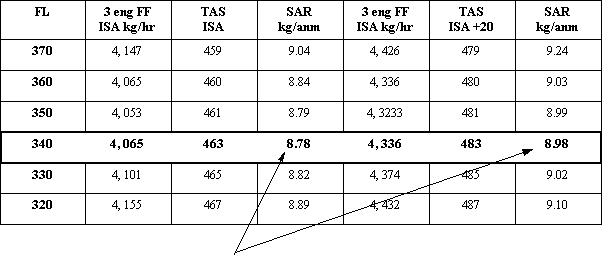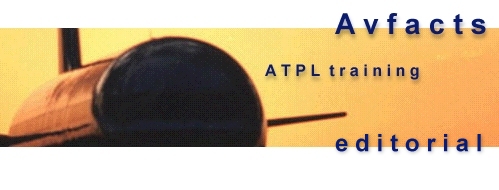|
|
|
|
|
|
|
|
|
|
|
|
|
|
|
|
|
|
|
|
|
|
|
General:
Generally speaking, the higher a jet aircraft flies, the more efficient it will be, and
the lower the fuel flow.
In other words specific fuel consumption (SFC) is less. That statement is true up to a
point. After a certain flight level called the optimum flight level SFC gets worse as fuel
flow increases again. This is due to the increased drag penalty above the optimum flight
level as a result of the excessive angle of attack (AoA) required to create enough lift to
support the aircraft. Eventually a flight level will be reached at which the AoA will
reach stall values.
Aircraft normally cruise with a positive nose up attitude, in swept wing jets this
typically approximately 2-3 degrees is the optimum to provide sufficient lift, while
limiting drag. You may have noticed cabin staff struggling to pull the meal service
trolley toward the front of the plane (ie: uphill).
Optimum altitude is a function of the fuel flow and the TAS. TAS reduces as an aircraft
climbs at a fixed Mach number into the cold air environment.
Fuel flow (FF) decreases with altitude up to a point, then increases thereafter. |
|
|
|
|
|
|
|
|
|
 |
|
|
|
|
|
|
|
|
|
Optimum FL is where the FF/TAS relationship gives the
lowest SAR ! |
|
|
|
|
|
|
|
|
|
|
|
|
|
|
|
|
|
|
|
|
 |
|
|
|
|
|
|
|
|
|
|
Optimum FL is NOT effected much by temperature as this
effects FF and TAS to approximately the same degree. |
|
|
|
|
|
|
|
|
|
|
|
|
|
|
|
|
|
|
|
 |
|
|
|
|
|
|
|
|
|
|
Optimum FL is concerned only with SAR. Head/Tail winds
are NOT considered. |
|
|
|
|
|
|
|
|
|
|
|
|
|
|
|
|
|
|
|
 |
|
|
|
|
|
|
|
|
|
|
|
|
|
|
Optimum FL for a zone is calculated using the EMZW.
|
|
|
|
|
|
|
|
|
|
|
|
|
|
|
|
|
|
|
 |
|
|
|
|
|
|
|
|
|
Specific Air Range (SAR) is the FF divided by TAS.
|
|
|
|
|
|
|
|
|
|
|
|
|
|
|
|
|
|
|
|
|
|
|
|
|
|
|
|
|
|
|
|
|
|
|
|
|
|
|
|
Practical example using the B727. Refer to the Mach 0.80
schedule on B727 manual page 3-93 extract below.
EMZW 70, 000 kg. Mach 0.80 |
|
|
|
|
|
|
|
|
|
|
 |
|
|
|
|
|
|
|
|
|
|
|
FL340 is optimum FL irrespective of ISA deviation.
(ie: SAR is lowest at FL340, due to best TAS/FF combination). |
|
|
|
|
|
|
|
|
|
|
|
|
|
|
|
|
Unfortunately FL340 is NOT an IFR hemispherical level. We
could use FL350 if travelling WEST, and FL330 travelling EAST, to get as close as possible
to the optimum level, and lower the zone fuel burn off (nil wind).
Note that SAR at ISA +20 is only about 2% higher than in ISA. A good rule is that SAR
varies approximately 1% per 10 degrees above/below ISA. Put another way, if enroute cruise
temperature is ISA+/-
10C, not correcting for TAS or FF for ISA deviation will produce a FBO in error only 100
kg on a 10, 000 kg
(1, 000 nm) flight. |
|
|
|
|
|
|
|
|
|
|
|
|
|
|
To assess which IFR FL is closest to the optimum for a
particular cruise zone, you simply compare the optimum GW at the IFR levels with the
estimated mid zone weight (EMZW). Whichever IFR level is closest in terms of GW is the
optimum IFR FL. Refer to example below. |
|
|
|
|
|
|
|
|
|
|
|
|
|
|
Example 1. Tracking EAST at FL330/M 0.80. EMZW for zone is
70, 000 kg. Temp all levels ISA.
What is the optimum IFR FL for the zone. (Refer page 2-14). |
|
|
|
|
|
|
|
|
|
|
 |
|
|
|
|
|
|
|
|
|
|
|
|
|
|
|
|
|
|
|
|
|
|
|
|
|
|
|
|
|
|
|
|
|
|
|
|
|
In this case you will burn less fuel in the zone if you
remain at FL330. Checking altitude capability at ISA shows that FL370 would infact not be
available until the aircraft GW had reduced to 69, 400 kg, which would occur beyond the
mid point of the zone. |
|
|
|
|
|
|
|
|
|
|
|
|
|
|
|
|
|
|
|
|
|
|
|
|
|
|
|
|
|
|
|
|
|
|
Airline crews attempt to be within 2, 500 ft of optimum FL
at any time if traffic is not a problem, and winds and turbulence are not adverse.
You should check that at the ISA deviation quoted that optimum FL does not exceed the
engines max cruise thrust limits. Selecting a lower mach number may assist. |
|
|
|
|
|
|
|
|
|
|
|
|
|
|
Example 2. Tracking WEST at FL310/M 0.79. EMZW for zone is
66, 000 kg. Temp all levels ISA +10.
What is the optimum IFR FL for the zone. (Refer page 2-14). |
|
|
|
|
|
|
|
|
|
|
 |
|
|
|
|
|
|
|
|
|
|
|
|
|
|
|
|
|
|
|
|
|
|
|
|
|
|
|
|
|
|
|
|
|
In this case you will burn less fuel in the zone if you
climbed to FL350. Checking altitude capability at ISA shows that FL350 is available before
the mid point of the zone. |
|
|
|
|
|
|
|
|
|
|
|
|
|
|
Example 3. Tracking EAST at FL330/LRC. EMZW for zone is
72, 000 kg. Temp all levels ISA -5.
What is the optimum IFR FL for the zone. (Refer page 2-14). |
|
|
|
|
|
|
|
|
|
|
 |
|
|
|
|
|
|
|
|
|
|
|
|
|
|
|
|
|
|
|
|
|
|
|
|
|
|
|
|
|
|
|
|
|
|
|
|
|
In this case you will burn less fuel in the zone if you
remain at FL330. Infact FL330 is obviously about perfect to limit the zone fuel burn.
Checking altitude capability at ISA shows that FL370 becomes available when the aircraft
GW has reduced to 70, 100 kg, though you would only climb to that level if winds,
turbulence or
traffic was a problem at FL330.
Slow traffic ahead at your level could see you have to slow down or climb above optimum to
allow you to pass that aircraft. Slow traffic can significantly ruin your day, especially
on long haul flights where crew duty times can be exceeded. It can also raise the fuel
burn, and in doing so reduce your range, which might have been a critical factor before
the slow traffic problem arose. |
|
|
|
|
|
|
|
|
|
|
|
|
|
|
Now attempt the optimum FL assignments. |
|
|
|
|
|
|
|
|
|
|
|
|
|
|
|
|
|
|
|
|
|
|
|
|
|
|
|
|
|
|
|
|
|
Assignment 1. Tracking WEST at FL310/M 0.82. EMZW for zone
is 69, 000 kg. Temp all levels ISA +5.
What is the optimum IFR FL for the zone. (Refer page 2-14). |
|
|
|
|
|
|
|
|
|
|
|
|
|
|
a. FL310
b. FL330 c. FL350
d. FL370 |
|
|
|
|
|
|
|
|
|
|
|
|
|
|
Assignment 2. Tracking EAST at FL290/M 0.84. EMZW for zone
is 81, 000 kg. Temp all levels ISA -5.
What is the optimum IFR FL for the zone. (Refer page 2-14). Ensure max cruise thrust
limits are not exceeded. |
|
|
|
|
|
|
|
|
|
|
|
|
|
|
a. FL290
b. FL330 c. FL370
d. FL350 |
|
|
|
|
|
|
|
|
|
|
|
|
|
|
Assignment 2. Tracking EAST at FL290/M 0.79. EMZW for zone
is 82, 000 kg. Temp all levels ISA.
What is the optimum IFR FL for the zone. (Refer page 2-14). Ensure max cruise thrust
limits are not exceeded. |
|
|
|
|
|
|
|
|
|
|
|
|
|
|
a. FL290
b. FL330 c. FL370
d. FL350 |
|
|
|
|
|
|
|
|
|
|
|
|
|
|
|
|
|
|
|
|
|
|
 |
|
|
|



















